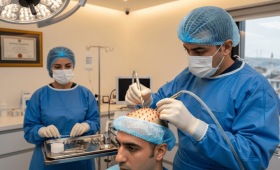Fundamental Principle in Hair Transplantation: The Rise of FUE
Hair transplantation is, fundamentally, a procedure where hair roots (grafts) are taken from one part of the body, typically the donor area at the back of the head, and transplanted to sparse or bald areas. These grafts are small pieces of tissue usually containing one to four hair strands.
Modern hair transplantation methods are based on the Follicular Unit Extraction (FUE) technique, which involves extracting these grafts one by one, leaving no linear scars. Developed in the early 2000s, FUE revolutionized hair transplantation by making it much less invasive and the recovery process much faster. However, technology has not stood still, and the FUE technique has branched out into sub-techniques. This is where the Sapphire FUE and DHI techniques emerged. Both of these methods are evolutions of FUE, taking hair transplantation to the next level.
What is Sapphire FUE Technique?
Sapphire FUE is a special version of the classic FUE technique. It gets its name from the cutting-edge sapphire mineral used in the blades that open the channels during the operation. Unlike the steel blades used in classic FUE, sapphire blades are sharper, smoother, and much more precise.
These blades are used to open micro-channels in the recipient area where the grafts, taken from the donor area, will be transplanted. The V-shaped tip of the sapphire blade allows for the creation of narrower channels, which makes it possible to achieve a denser and more natural-looking result. This minimizes tissue trauma, reduces bleeding, and speeds up the healing process. This method is ideal for transplants covering large areas.
What is DHI Technique?
DHI stands for “Direct Hair Implantation.” Although the graft collection process in this technique is similar to classic FUE, the implantation phase is entirely different. In DHI, a special tool called the Choi Implanter Pen is used. This pen has the ability to both open the channel and implant the graft at the same time.
Grafts are placed into the pen and injected under the skin with a single touch from the surgeon. This minimizes the time grafts spend outside the body, which increases the graft survival rate. The DHI technique is particularly suitable for patients who want to have hair transplanted between existing hairs or who do not want to completely shave their donor area.
The Main Difference Between Sapphire FUE and DHI
Although both methods are sub-branches of FUE, the main difference lies in the graft implantation stage. In Sapphire FUE, grafts must be placed into pre-opened channels with a special tweezer-like tool. This is a two-step process: first the channels are opened, then the grafts are implanted. DHI, on the other hand, is a single-step procedure. The Choi Implanter Pen simultaneously opens the channel and implants the graft. This difference gives each method its unique advantages and disadvantages. Sapphire FUE allows for faster work on larger areas, while DHI offers more precise and controlled implantation.
Operation Process: How is Sapphire FUE Performed?
The Sapphire FUE operation consists of three main stages. First, the recipient area for the hair transplant and the donor area from which the grafts will be taken are determined. Then, the grafts are extracted one by one from the donor area using a special device called a micromotor. These grafts are then placed into a special solution to preserve their vitality.
The second stage is one of the most critical: opening the channels. This is where the Sapphire FUE technique comes into play. Micro-channels are opened in the recipient area with special sapphire-tipped blades. The angle and density of these channels directly affect the naturalness of the result. Finally, the collected grafts are carefully placed one by one into these channels. Each of these three stages is of great importance for the success of the outcome.
Operation Process: How is DHI Performed?
The DHI operation also begins similarly, but the implantation stage differs. First, grafts are collected from the donor area using the FUE technique. The collected grafts are then placed one by one into the Choi Implanter Pens without losing their vitality. The graft placed in each pen is now ready for transplantation. This process combines the channel opening and graft implantation stages.
The surgeon pushes the tip of the pen directly into the bald or sparse area and, with a special mechanism, injects the graft into the skin at the correct angle and direction at the same time. In this way, the channel opening and graft implantation are completed simultaneously. The DHI technique eliminates the need to touch the grafts during transplantation, which helps prevent damage to the grafts.
Which Method is More Suitable for Which Cases?
Each of the Sapphire FUE and DHI techniques may be more suitable for different patient types and needs. Sapphire FUE offers a faster and more effective solution, especially when a large area needs a hair transplant, for example, if there is complete baldness on the scalp or if a high number of grafts is required. DHI is more often preferred for smaller areas, where the hairline needs to be densified, for beard or eyebrow transplantation, and when transplanting between existing hairs. The fact that DHI offers a more controlled implantation provides a great advantage, especially in cases where the exit direction of the hair roots needs to be adjusted very precisely.

Need for a High Number of Grafts
One of the most important factors determining the success of a hair transplant is whether the number of transplanted grafts can meet the patient’s needs. The Sapphire FUE technique can be more efficient, especially for transplants of 4000 grafts or more. The reason for this is that the channel opening process with sapphire blades is completed faster than with DHI.
The DHI technique, on the other hand, can take longer because each graft needs to be placed into a Choi pen one by one. For this reason, if a large number of grafts are to be transplanted, the prolonged operation time may negatively affect the patient’s comfort. In such cases, Sapphire FUE is more often preferred to make the operation faster and more comfortable.
Application to Thinning Hair and Natural Appearance
The most desired result in hair transplantation is for the hair to look natural and dense after the procedure. At this point, both methods have their own unique advantages. The DHI technique is ideal for transplanting between existing hairs. Thanks to the Choi pen, grafts can be placed in the correct angle and direction without damaging the existing hair roots.
This is a great advantage, especially for patients who do not want to completely shave their heads. Sapphire FUE, on the other hand, allows for a much denser appearance in the transplanted area, thanks to the ability of sapphire blades to open smaller and denser channels. The naturalness of the results of both methods depends on the experience and artistic talent of the surgeon performing the operation.
Shaved or Unshaved Hair Transplant
For many people considering a hair transplant, one of the most important issues is whether the hair needs to be completely shaved. The DHI technique can be applied without the need to completely shave the donor area. This is an important advantage for patients who want to maintain the privacy of the operation or do not want to shorten their hair.
In DHI, only the areas from which grafts will be taken can be shaved, or grafts can be collected in a shaved strip without shaving the entire head. The Sapphire FUE technique, on the other hand, usually requires the donor and recipient areas to be completely shaved, as it requires opening channels over a larger area. This decision varies according to the patient’s personal preference and the extent of hair loss.
Healing Process and Scabbing
The post-operative healing process is one of the most curious topics for patients. In the Sapphire FUE technique, since channels are opened beforehand for the placement of grafts, more scabbing and redness can be seen after the operation. Despite the minimal trauma caused by the sapphire blade, the individual placement of the grafts can lead to the formation of small scabs in this area.
In the DHI technique, since channel opening and graft placement are done simultaneously, there may be less bleeding and scabbing. Generally, the healing process of the DHI operation can be slightly faster and more comfortable than Sapphire FUE. However, the healing process for both methods can vary from person to person.
Pain and Comfort Level
Hair transplant operations are generally painless because they are performed under local anesthesia. Except for the short-term discomfort caused by the anesthetic injections, patients do not feel any pain during the procedure. In Sapphire FUE, because the sapphire blade is sharper, it causes less bleeding and tissue trauma, so post-operative pain is minimal. The DHI technique, thanks to the single-step procedure of the Choi pen, offers a very comfortable experience both during and after the operation. Both methods provide a comfortable process for patients thanks to modern equipment and anesthesia techniques.
Tools Used: Sapphire Blades and Choi Pens
The most distinct feature that separates the two methods is the tools used. In Sapphire FUE, special blades made of sapphire mineral are used. These blades are V-shaped and have very thin tips, which allows for more precise channel opening. The smooth surface of the sapphire mineral also reduces the risk of allergic reactions. In DHI, a special tool called the Choi Implanter Pen is used. Thanks to the mechanism inside, these pens take the graft and, with the pressure applied by the surgeon, place the graft under the skin at the correct depth and angle. The Choi pen allows for a denser implantation of grafts in the recipient area and makes it easier to adjust the angle of implantation.
Potential Risks and Side Effects
Although hair transplant operations are generally safe procedures, they can carry some risks, as with any surgical intervention. Infection, bleeding, swelling, bruising, and numbness are among the most common side effects. In Sapphire FUE, since it requires working on a larger area, minimal bleeding and swelling can be seen. The DHI technique, on the other hand, minimizes these risks due to less bleeding and tissue trauma. However, these risks vary depending on the clinic’s hygiene standards, the surgeon’s experience, and how well the patient follows post-operative care instructions. Choosing a reliable clinic is critical in reducing these risks.
Success Rate and Graft Survival Rates
Both Sapphire FUE and DHI techniques have a high success rate. However, the DHI technique can theoretically offer a higher graft survival rate because it minimizes the time grafts spend outside the body. After grafts are taken from the donor area, they carry the risk of coming into contact with air and losing their vitality. In DHI, the grafts are placed directly into the Choi pen and transplanted without waiting, which reduces the possibility of damage to the grafts. In Sapphire FUE, the grafts may wait for a while outside, so they must be kept in a special solution to maintain their vitality.
The Importance of Choosing the Right Clinic
In a hair transplant operation, choosing the right clinic and expert surgeon is just as vital as the choice of technique. Techniques such as Sapphire FUE and DHI are shaped by the surgeon’s dexterity and experience. The clinic’s hygiene standards, the quality of the equipment used, and the pre- and post-operative support services directly affect the success of the operation.
Therefore, it is necessary to do extensive research, examine the experiences of patients who have undergone the procedure before, and meet with the clinics in person. Clinics that provide services at international standards, such as Cure Holiday, offer you professional support throughout this entire process.
Cost Comparison
Hair transplant prices vary depending on the technique chosen, the number of grafts to be transplanted, and the city where the clinic is located. The DHI technique, because it requires a longer and more meticulous process, can often be more costly than Sapphire FUE. The reason for this is that the DHI pen is single-use and the operation takes more time. Sapphire FUE, on the other hand, can be more affordable because it allows for denser graft transplantation than DHI and progresses faster. However, the price for both methods can vary with factors such as the quality of the clinic and additional services (accommodation, transfer, etc.).

Time Until Results are Visible
It takes some time for the results of a hair transplant to fully settle. Within the first few weeks, the transplanted hair undergoes a process called shock loss. This is an expected and normal situation. The new hair starts to grow back approximately 3 months after the operation. At 6 months, 60-70% of the results are visible. The final results appear within 12 to 18 months. There is no major difference in the time it takes for results to be visible between the Sapphire FUE and DHI techniques. Both methods offer permanent and natural results.
Advantages and Disadvantages of Both Methods
Sapphire FUE Advantages:
- Faster and more suitable for large-area transplants.
- Minimal bleeding and tissue trauma.
- Provides a denser transplant.
Sapphire FUE Disadvantages:
- The time grafts spend outside the body is longer than with DHI, as the channels are opened beforehand.
- The donor area may need to be completely shaved.
DHI Advantages:
- Graft survival rate can be higher.
- Ideal for transplanting between existing hairs.
- Offers the possibility of unshaved transplantation.
- The healing process can be faster.
DHI Disadvantages:
- Can take longer, which is not ideal for high numbers of grafts.
- Generally more costly than Sapphire FUE.
- Allows for a limited number of grafts to be transplanted.
Why Turkey and Cure Holiday?
Turkey is a world leader in the field of hair transplantation. The reason for this success is the experienced surgeons, modern clinics, affordable prices, and excellent service quality. Turkey uses the latest technologies, such as both Sapphire FUE and DHI, to offer patients the best results. Cure Holiday is a brand that specializes in this field and always prioritizes patient satisfaction.
When you have a hair transplant with Cure Holiday, you receive a comprehensive package that includes not only the operation itself but also all related services such as airport transfer, luxury accommodation, and post-operative follow-up. This makes the entire process much easier and more comfortable for patients coming from abroad.
Experience with Cure Holiday: From First Consultation to Final Check-up
Cure Holiday accompanies you from beginning to end on your hair transplant journey. The first step is a free online consultation with an expert consultant. During this consultation, a hair analysis is performed, the most suitable method for you is decided, and a transplant plan is created. On the day of the operation, the procedure is performed by experienced surgeons. After the operation, regular check-ups are done to follow your healing process and all your questions are answered. This personalized approach makes patients feel safe and creates the best environment for a successful outcome.
The Future of Both Techniques
Hair transplantation technologies are constantly evolving. Although Sapphire FUE and DHI are currently the most advanced methods, it is likely that even newer and more advanced techniques will emerge in the future. Research shows that methods such as stem cell technology and cloning can revolutionize the field of hair transplantation. However, these technologies are not yet ready for clinical use. For now, Sapphire FUE and DHI continue to be the most reliable and proven methods that offer the best results.
Hair Transplant Preparation Process
Before a hair transplant operation, some important points must be considered. It is recommended to stop using alcohol and tobacco at least one week before the operation. The use of blood thinners and herbal supplements may also need to be discontinued for a while. These precautions help the operation proceed more smoothly and speed up the healing process. Cure Holiday‘s expert consultants will share this detailed information with you before the operation.
Frequently Asked Questions about Hair Transplantation
- At what age should a hair transplant be done? The late 20s and early 30s, when hair loss has stabilized, are generally ideal.
- How long does the procedure take? It can take 4 to 8 hours, depending on the number of grafts.
- Is the donor area damaged? When performed by an experienced surgeon, there is no permanent damage to the donor area.
- Does the transplanted hair fall out? The transplanted hair roots are genetically resistant to shedding and are therefore permanent for life.
Conclusion: What Does the Right Decision Mean for You?
The choice between Sapphire FUE and DHI depends on your personal hair loss situation, expectations, and budget. Both methods can offer excellent results, but they may be more suitable for different scenarios. If you want to achieve density in a large area, Sapphire FUE may be a better option for you.
If you are looking for a more precise transplant while preserving your existing hair, DHI may be a better option. To make the most accurate decision, it is best to consult with an expert surgeon and evaluate your personal situation. You can contact Cure Holiday for a free consultation and find out which method is most suitable for you. Remember, with the right technique and the right experts, it is now possible to have the hair of your dreams.



